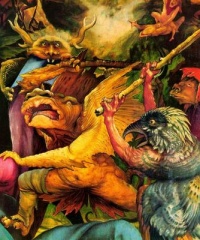Saint
From The Art and Popular Culture Encyclopedia
_-_Gustave_Moreau.jpg)
|
"Contemporary literature was almost exclusively confined to Lives of the Saints,—the legend of St. Columba by the cenobite Jonas and that of the Blessed Cuthbert compiled by the Venerable Bede from the notes of an anonymous monk of Lindisfarne, he confined himself to turning over at odd moments the pages of these Hagiographers and re-reading extracts from the Lives of St. Rusticula and St. Radegonde, related, the former by Defensorius, Synodite of Ligugé, the latter by the modest and simple-hearted Baudonivia, a Nun of Poitiers.."--À rebours (1884) by Joris-Karl Huysmans "The earliest specimens of northern French literature are metrical Lives of the Saints. These are supposed to have been translated from Latin compositions about the middle of the eleventh century. "--History of Fiction (1814) by John Colin Dunlop |

|
Related e |
|
Featured: |
In religious belief, a saint is a person who is recognized as having an exceptional degree of holiness, likeness, or closeness to God.
The English word saint originated in Christianity and derives from the Latin sanctus, with the Greek equivalent being ἅγιος (hagios) 'holy'.
Contents |
See also
List of saints
Further reading
- The Sex Lives of Saints: An Erotics of Ancient Hagiography (2003) by Virginia Burrus
Depictions
- Saint symbolism
- The Death of St Agnes (1635) by Francesco Cairo
- Halo (religious iconography)
- The Hermit Saints
- List of depictions of the Virgin and Child
- Archangel Michael in Christian art
- Religious images in Christian theology
- Marian art in the Catholic Church
.jpg)

